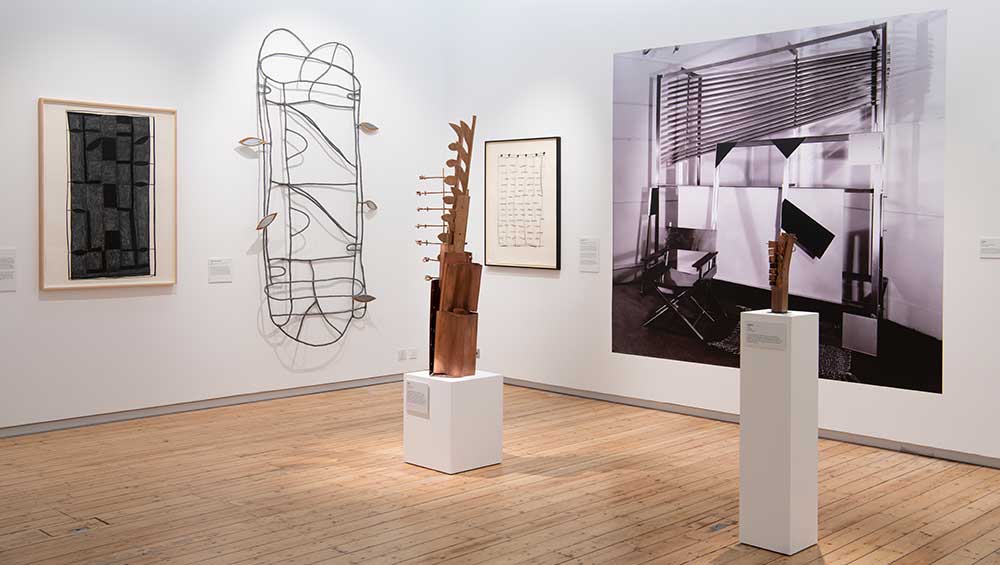
Matt Rugg: Connecting Form, installation view, Hatton Gallery, Newcastle. Photo: Colin Davison.
Hatton Gallery, Newcastle
23 September 2023 – 13 January 2024
by BETH WILLIAMSON
You may never have heard of the British abstract artist Matt Rugg (1935-2020), or, if you have, it will probably be within the context of mid-20th century art education in Britain. It is a matter of record that Rugg studied fine art at King’s College, Newcastle (then part of the University of Durham), from 1956 under the tutelage of Victor Pasmore (1908-98) and Richard Hamilton (1922-2011). At that time, Pasmore and Hamilton ran the revolutionary “basic course” (elsewhere known as “basic design”, “basic form” or “basic research”), a pedagogical approach that shifted focus and equipped students with a grammar, an understanding of space, form and colour, that acted as a vocabulary or lexicon for making that freed them up from any need for representation. Similar approaches had earlier emerged in the Bauhaus Vorkurs, a preliminary course begun by Johannes Itten (1888-1967), aspects of which were taken up in London art schools, especially Camberwell School of Art in the 1930s and the Central School of Arts and Crafts in the 1940s and 1950s under the principalship of William Johnstone (1897-1981). These developments have been charted elsewhere so there is no need to rehearse them further.1 What is important here is Rugg’s experience of that training and where it took him.2
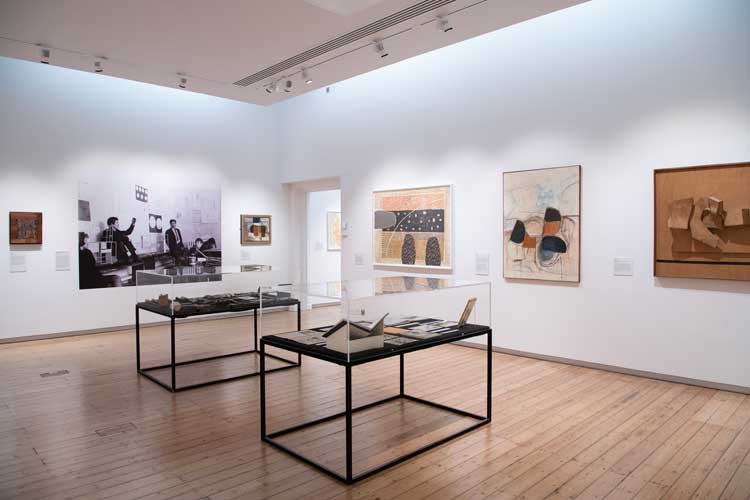
Matt Rugg: Connecting Form, installation view, Hatton Gallery, Newcastle. Photo: Colin Davison.
Rugg taught, too, first as a studio demonstrator in the department at Newcastle for two years before being appointed lecturer in painting for two further years. It was in 1965 that he established his south London studio and was appointed as a lecturer at Chelsea School of Art, first in painting (1965-67), then in sculpture (1967-94). Despite early successes in exhibiting his own work in the 60s and 70s, Rugg largely shunned exhibiting until the 2000s, pouring his energies instead into teaching and making work in his studio.3 Over the decades, and like his fellow Newcastle alumni, he showed tremendous support for the basic course, as well as respect and gratitude for the teaching of Hamilton and Pasmore.
The present exhibition is the first major retrospective of Rugg’s work. Focusing on Rugg as an artist with a long and productive career, rather than Rugg as a student of Hamilton and Pasmore, it reveals how he developed a unique practice that put sculpture, painting and drawing into a symbiotic relationship. Rugg had an architectural sense of design and space, a playful curiosity for found industrial materials, and an unswervingly experimental eye, and his work comes out of the shadows in this exhibition.
Filling all four rooms of the Hatton’s galleries with its presence, it is clear from the outset that there is no straightforward linear development in the artist’s work. There are common themes, reference points and materials, but these cut across the years and Rugg’s different modes of making. As the exhibition’s curator, Harriet Sutcliffe, has put it: “There is a consistency in Rugg’s language, rhythm and motif that runs through his work. From industrial landscapes to music, grids, design and architecture, to found objects, materials and maps – the simplicity and complexity of line and form are themes that riveted Rugg’s imagination.”4 So, how does this play out in the exhibition?
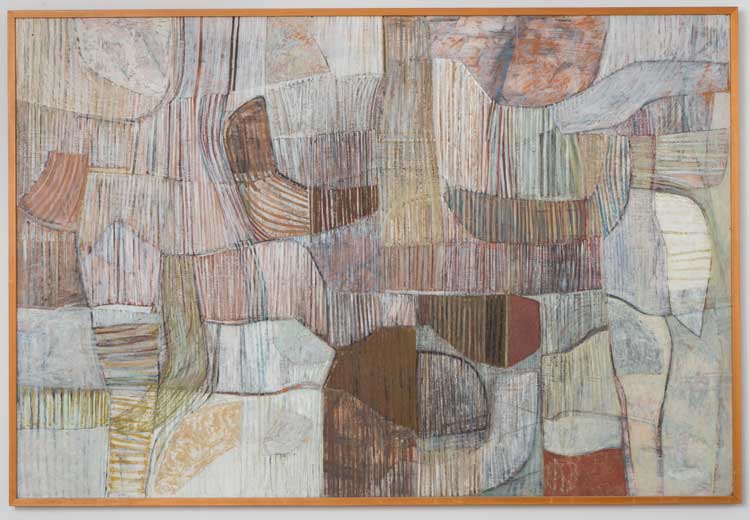
Matt Rugg, Anatomy of the Painting, 1960. Private collection, © Estate of Matt Rugg. Photo: Mark Pinder.
In the first room, we immediately see the continuity between early and late work. Many of Rugg’s works are untitled, but there are some exceptions. His work Anatomy of the Painting (1960) was shown in his degree show and in the 1961 Young Contemporaries exhibition in London. Visually, this work, undoubtedly references Pasmore’s work of the previous decade, such as The Wave or Spiral Motif in Green, Violet, Blue and Gold: the Coast of the Inland Sea, both from 1950. However, Anatomy of the Painting has other attributes. Rugg called it an “anatomy” of painting because he felt it got to the heart of something, an essence. As the writer Michael Bird explains: “To anatomise is to analyse the parts that make up the whole, but its purpose is synthetic – to comprehend or hold together in the mind.”5 It is an idea that Rugg would return to much later.
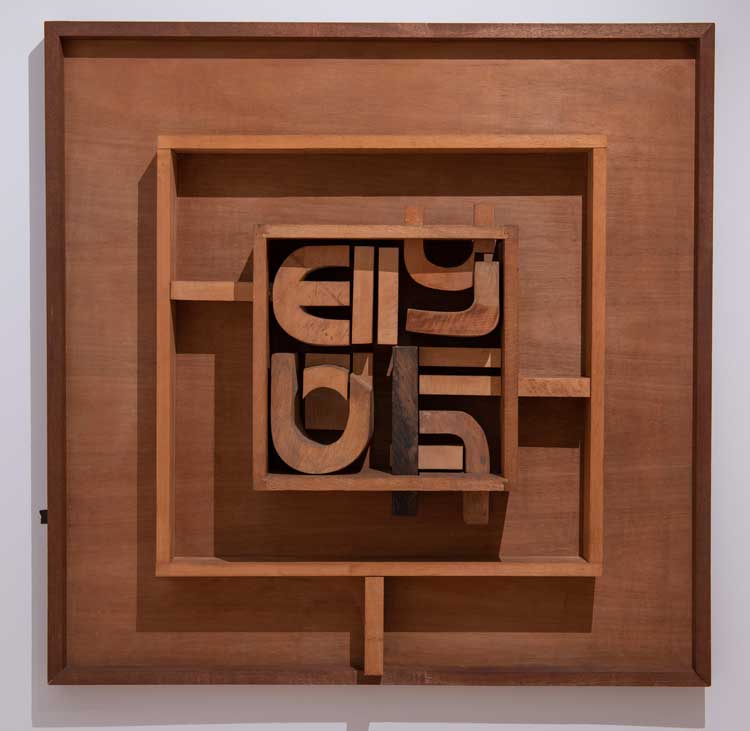
Matt Rugg, Sign Elements III, 1963. Leeds City Art Gallery © Estate of Matt Rugg, Photo: Colin Davison.
Elsewhere in this first room, the formal graphic nature of a work such as Sign Elements III (1963) is unusual for Rugg. Boomerang (1962), on the other hand, reverts to more organic modular forms that seem to fit harmoniously together, as if in a kind of architectural model.

Matt Rugg, Boomerang, 1962. Private collection. © Estate of Matt Rugg, Photo: Colin Davison.
There is a real sense of the artist at work in this room and a small vitrine in the centre shares something of his resourcefulness. For, not only did he repurpose tools to his own ends (a floristry frog becomes a tool to scrape and mark), he forged new tools from scratch to meet his own requirements.
In the next gallery space, there is so much to tease and delight the eye. In one corner is a newly commissioned film about Rugg. A row of small plinth-mounted sculptures punctuates the centre of the space, running down its length like a spine. Each sculpture is made from pieces of galvanised steel sheet and wire, and other industrial materials such as webbing and plastic in various forms.
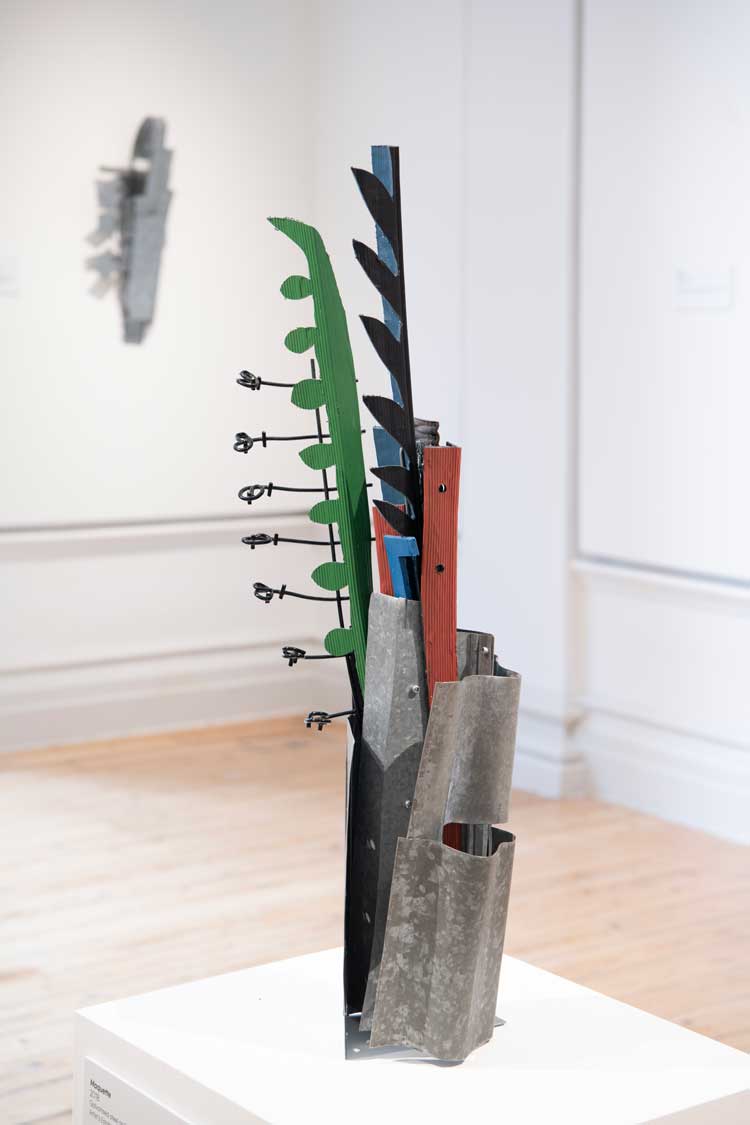
Matt Rugg, Maquette, 2018. Private collection, © Estate of Matt Rugg. Photo: Colin Davison.
The final sculpture in this spinal column is Maquette (2018), materially much like others in the lineup, except that the energy in its curved base is a tribute to the Finnish architect Alvar Aalto (1898-1976). Its general sense of growth and movement is furthered by the inclusion of several discrete elements that recollect plant and flower forms. A cut-off strip of plastic-coated wire mesh concludes with a row of roughly curled and twisted ends that resemble musical notes.
This gesture to musical notation in Rugg’s work is unsurprising. As can be seen throughout this gallery, his concern with notation and interest in abstract musical compositions, and a particular interest in the ideas of the music of John Cage (1912-92), inspired Rugg’s two- and three-dimensional work. There are drawings, paintings and wall reliefs in this space, as well, far too many to mention, but beautifully paced around the room. In the instance of Confluence (2014-16), a low-level installation comprising seven separate sculptures made from galvanised steel wire and industrial belt, its form and materials together demonstrate Rugg’s ability to balance formal concerns with the need for improvisatory composition, as in music.
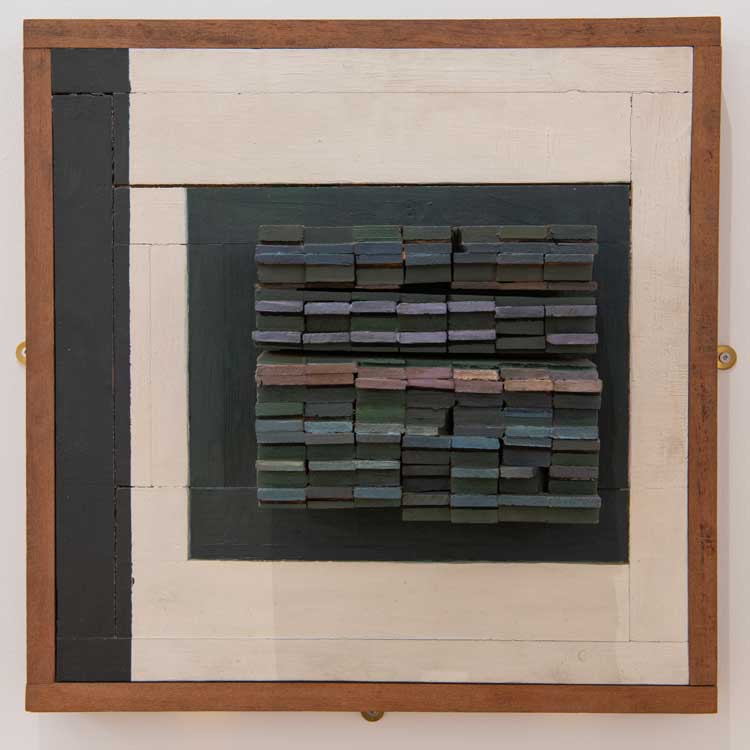
Matt Rugg, Painted Unit Relief, 1963. Tate © Estate of Matt Rugg, Photo: Colin Davison.
The small central gallery space includes the exquisite Painted Unit Relief (1963), on loan from Tate’s collection. The gentle and considered gradation of colours across the surface of the work displays a particular depth and richness. This, alongside the cut surface of each small wooden element, drenched in colour, suggests the naturally coloured fluids that ooze from a cut stem or branch at different stages of its life and gradual decay.
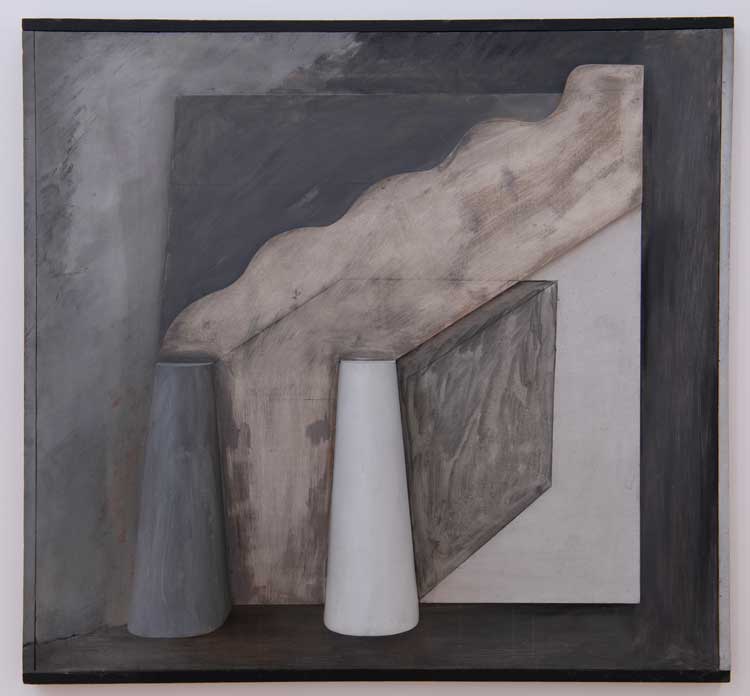
Matt Rugg, Industrial Landscape II, 1966. British Council Collection. © Estate of Matt Rugg, Photo: Colin Davison.
As a counterpoint to this, Painted Unit Relief is shown alongside Industrial Landscape II (1966). The latter, made from painted wood and polyester resin, shows the industrial cooling towers that are still visible on the train journey between London and Newcastle. The passage that runs from this gallery to the next takes visitors through the heart of the Hatton and past the permanent installation of the Merz Barn Wall by Kurt Schwitters (1887-1948). Usually, this is a hiatus in any Hatton exhibition, an aside almost. For the present exhibition, however, Sutcliffe has used the space to enrich visitors’ conversation with Rugg by hanging a few small drawings which, although not directly linked to the Merz Barn Wall, form their own architectural conversation with it, while reflecting Rugg’s interest in rural and urban environments.
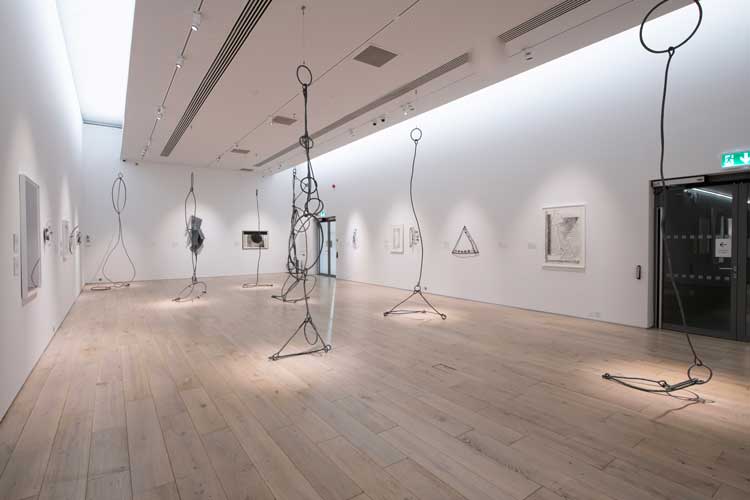
Matt Rugg, Anatomy Series, 1999-2015. Private collection © Estate of Matt Rugg, Photo: Colin Davison.
Nothing quite prepares you for the final gallery in this exhibition. It seems to be fashionable to talk about an exhibition’s crescendo these days, saving the best until last, if you like. In this case, the term would certainly fit in respect of Rugg’s musical interest. However, that idea of a crescendo is as something external, happening outside of us, and so this room is more of an awakening, an emotional and psychological experience that is awe-inspiring. The walls are hung sparingly and eight sculptures from Rugg’s Anatomy Series (1999-2015) hang lightly throughout the space. The sparseness here is crucial to the experience of this room.
The Anatomies, as they are known, consist of metres and metres of hand-coiled steel wire, stretching from floor to ceiling, twisted and grappled into shape, drawings in space, the line freed from the page. Despite their scale, and their incongruous lightness of being in the space, the Anatomies seem to possess a human sensibility and an enormous emotional presence. In some respects, they make sense of everything else in the exhibition, perhaps because they embody the well-known idea of Paul Klee (1879–1940) that a drawing is “an active line on a walk, moving freely.”6 Klee taught at the Bauhaus, home of the Vorkurs that later informed basic design in British art schools and the basic course at Newcastle that was formative for Rugg. It would be wrong to place too much store on the kind of hegemonic chains of influence and events this lineage suggests, but Rugg’s Anatomies loop around, turn back on themselves, seeming to hover between the organic and inorganic and suggest a final freeing and stripping back of Rugg’s practice. If the basic course gave Rugg a vocabulary, a lexicon to work with day after day, it was Rugg himself who distilled and enriched that vocabulary –yes, nodding to the basic course and its predecessors, but equally inflected by his own decades of teaching others and refining his own making.
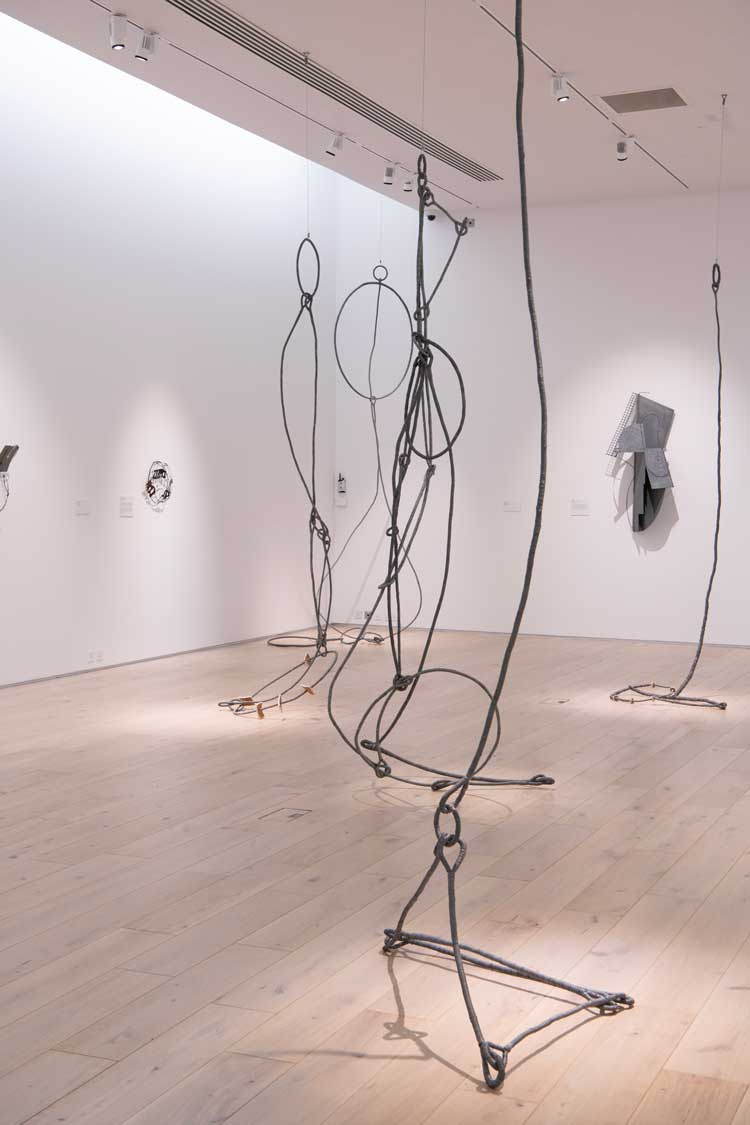
Matt Rugg: Connecting Form, installation view, Hatton Gallery, Newcastle. Photo: Colin Davison.
Ultimately, Rugg’s artistic career may have begun under the pedagogic eye of Hamilton and Pasmore, but it flourished, developed and came to a conclusion on its own terms, on his terms. From his exploration of the grid to architectural-type drawings. From fully three-dimensional plinth pieces to flattened works that act as painting rather than sculpture, from drawing in pencil to drawing in wire, from industrial materials to musical notation, from the overwhelming presence of his huge Anatomy sculptures, to the intimacy and poignancy of a tiny wire drawing made just before he died. Despite the nature of Rugg’s materials, none of the work on show here feels raw or unfinished, it is entirely complete in every respect. The smallest sketch made with the lightest touch displays a degree of completeness not only materially and aesthetically, but ethically too. That ethics emerges from Rugg’s decades-long dedication to teaching and making on his own terms, slipping seamlessly back and forth between media. It is Rugg’s strength of vision, discipline and deeply principled practice that is finally revealed in this exhibition.
References
1. Basic Design by Elena Crippa and Beth Williamson (eds), published by Tate, 2013, published by Tate, 2013, published by Tate, 2013
2. The Basic Course at Newcastle: Teachers and Students by Harriet Sutcliffe, in Matt Rugg: The Many Languages of Sculpture by Michael Bird with Harriet Sutcliffe, published by Lund Humphries, 2023, pages 115-131.
3. See Matt Rugg’s biography.
4. Quoted in exhibition press release.
5. Matt Rugg: The Many Languages of Sculpture, op cit, page 11.
6. Pedagogical Sketchbook [1925] by Paul Klee (translated by Sibyl Moholy-Nagy), published by Faber & Faber, 1968, page 16.